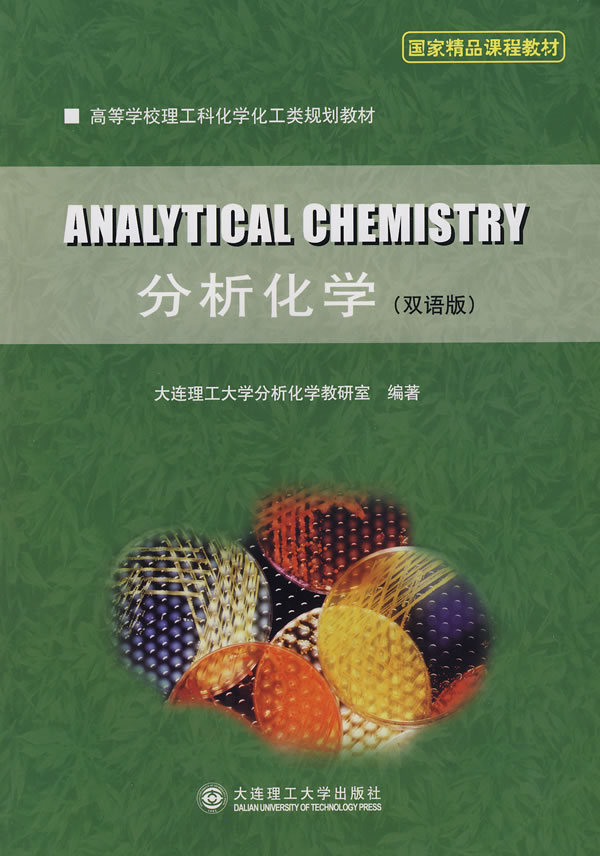
分析化学-(双语版)

温馨提示:5折以下图书主要为出版社尾货,大部分为全新(有塑封/无塑封),个别图书品相8-9成新、切口有划线标记、光盘等附件不全详细品相说明>>
- ISBN:9787561144237
- 装帧:暂无
- 册数:暂无
- 重量:暂无
- 开本:其它
- 页数:314
- 出版时间:2008-11-01
- 条形码:9787561144237 ; 978-7-5611-4423-7
内容简介
本教材在章节顺序和内容安排上参照了《分析化学》(第三版,大连理工大学分析化学教研室组编,刘志广主编)中文教材,将众多分析方法按大类编写,同时加强仪器分析内容,突出工科特点,在符合发展趋势及社会需要的同时重视学习的规律和逻辑性。英文内容以高等学校化学化工专业本科生少学时分析化学课程教学大纲为依据,参考多种国外原版教材,以使语言表述准确、地道。为使学生在习惯用英文进行专业思考的同时,又熟悉相应的中文用语,在每章末列出该章用到的主要专业名词的中文解释,以及用中文书写的重点内容概述。
目录
1.1 the nature of analytical chemistry 分析化学的性质
1.2 the role of analytical chemistry 分析化学的作用
1.3 the classification of analytical chemistry分析化学的分类
1.4 the total analytical process分析全过程
terms to understand
重点内容概述
chapter 2 errors and data treatment in quantitative analysis 定量分析中的误差及数据处理
2.1 fundamental terms of errors误差的基本术语
2.2 types of errors in experimental data实验数据中的误差类型
2.2.1 systematic errors 系统误差
2.2.2 random errors偶然误差
2.3 evaluation of analytical data分析数据的评价
2.3.1 tests of significance显著性检验
2.3.2 rejecting data可疑值取舍
2.4 significant figures有效数字
problems
terms to understand
重点内容概述
chapter 3 titrimetric analysis滴定分析法
3.1 general principles基本原理
3.1.1 relevant terms of titrimetric analysis滴定分析相关术语
3.1.2 the preparation of standard solution and the expression of concentration 标准溶液的配制与浓度表示方法
3.1.3 the types of titrimetric reactions滴定反应类型
3.2 acid-base titration酸碱滴定
3.2.1 acid-base equilibria 酸碱平衡
3.2.2 titration curves滴定曲线
3.2.3 acid-base indicators酸碱指示剂
3.2.4 applications of acid-base titration酸碱滴定的应用
3.3 complexometric titration配位滴定
3.3.1 metal-chelate complexes金属螯合物
3.3.2 edta 乙二胺四乙酸
3.3.3 edta titration curves edta滴定曲线
3.3.4 metal ion indicators金属离子指示剂
3.3.5 applications of edta titration techniques edta滴定方法的应用
3.4 oxidation-reduction titration氧化还原滴定
3.4.1 redox reactions氧化还原反应
3.4.2 rate of redox reactions氧化还原反应的速率
3.4.3 titration curves滴定曲线
3.4.4 redox indicators氧化还原指示剂
3.4.5 applications of redox titrations氧化还原滴定的应用
3.5 precipitation titration沉淀滴定
3.5.1 precipitation reactions沉淀滴定反应
3.5.2 titration curves滴定曲线
3.5.3 end-point detection终点检测
problems
terms to understand
重点内容概述
chapter 4 potentiometry 电位分析法
4.1 introduction简 介
4.1.1 classes and characteristics分类及性质
4.1.2 definition定 义
4.2 types of potentiometric electrodes电极种类
4.2.1 reference electrodes 参比电极
4.2.2 indicator electrodes指示电极
4.2.3 electrode response and selectivity电极响应及选择性
4.3 potentiometric methods and application电位法及应用
4.3.1 direct potentiometric measurement 直接电位法
4.3.2 potentiometric titrations电位滴定
4.3.3 applications of potentiometry 电位法应用
problems
terlns to understand
重点内容概述
chapter 5 chromatography色谱法
5.1 an introduction to chromatographic methods色谱法概述
5.2 fundamental theory of gas chromatography气相色谱基本原理
5.2.1 plate theory塔板理论
5.2.2 kinetic theory(rate theory) 速率理论
5.2.3 the resolution rs as a measure of peak separation 分离度
5.3 gas chromatography 气相色谱
5.3.1 components of a gas chromatograph 气相色谱仪的组成
5.3.2 stationary phases for gas-liquid chromatography 气液色谱固定相
5.3.3 applications of gas-liquid chromatography 气液色谱的应用
5.3.4 adsorption chromatography 吸附色谱
5.4 high performance liquid chromatography 高效液相色谱
5.4.1 instrumentation 仪器组成
5.4.2 high-performance partition chromatography 高效分配色谱
5.5 miscellaneous separation methods 其他分离方法
5.5.1 high-performance ion-exchange chromatography 高效离子交换色谱
5.5.2 capillary electrophoresis 毛细管电泳
5.5.3 planar chromatography 平板色谱
problems
terms to understand
重点内容概述
chapter 6 atomic absorption spectrometry原子吸收光谱分析法
6.1 introduction 概述
6.2 principles 原理
6.2.1 the process of aas,resonance line and absorption line 原子吸收光谱法的过程,共振线及吸收线
6.2.2 the number of ground atom and the temperature of flame 基态原子数与光焰温度
6.2.3 quantitative analysis of aas原子吸收光谱定量分析
6.3 instrumentation 仪 器
6.3.1 primary radiation sources 光源
6.3.2 atomizer 原子仪器
6.3.3 optical dispersive systems 分光系统
6.3.4 detectors 检测器
6.3.5 signal measurements 信号测量
6.4 quantitative measurements and interferences 定量测定及干扰
6.4.1 quantitative measurements 定量测定
6.4.2 interferences 干扰
6.4.3 sensitivity
6.5 applications of aas原子吸收光谱法的应用
problems
terms to understand
重点内容概述
chapter 7 ultraviolet and visible spectrophotometry 紫外-可见分光光度法
7.1 introduction简 介
7.2 ultraviolet and visible absorption spectroscopy 紫外-可见吸收光谱
7.2.1 introduction for radiant energy 辐射能简介
7.2.2 selective absorption of radiation and absorbance spectrum 物质对光的选择性吸收和吸收光谱
7.2.3 absorbing species and electron transition 吸收物质与电子跃迁
7.3 law of absorption吸收定律
7.3.1 lambert-beer's law朗伯-比尔定律
7.3.2 absorptivity吸光系数
7.3.3 apparent deviations from beer's law对比尔定律的明显偏离
7.4 instruments仪器
7.5 general types of spectrophotometer分光光度计种类
7.6 application of uv-vis absorption spectroscopy 紫外-可见吸收光谱的应用
7.6.1 application of absorption measurement to qualitative analysis 光吸收测定在定性分析上的应用
7.6.2 quantitative analysis by absorption measurements 光吸收测量定量分析法
7.6.3 derivative spectrophotometry 导数分光光度法
problems
terms to understand
重点内容概述
chapter 8 infrared absorption spectroscopy红外吸收光谱
8.1 theory of infrared absorption红外吸收基本原理
8.1.1 dipole changes during vibrations and rotations 振转运动中的偶极距变化
8.1.2 mechanical model of stretching vibrations 伸缩振动机械模型
8.1.3 quantum treatment of vibrations 振动的量子力学处理、
8.1.4 types of molecular vibrations分子振动形式
8.2 infrared instrument components红外仪器组成
8.2.1 wavelength selection波长选择
8.2.2 sampling techniques 采样技术
8.2.3 infrared spectrophotometers for qualitative analysis 定性分析用红外分光光度计
8.2.4 other techniques其他技术
8.3 the group frequencies of functional groups in organic compounds 有机化合物官能团的特征频率
8.4 the factors affecting group frequencies 影响基团特征吸收频率的因素
8.4.1 adjacent groups 邻近基团的影响
8.4.2 hydrogen bonding 氢键
8.5 qualitative applications to structural analysis 结构分析的定性应用
problems
terms to understand
重点内容概述
chapter 9 nuclear magnetic resonance spectroscopy 核磁共振波谱法
9.1 theory of nuclear magnetic resonance 核磁共振理论
9.1.1 quantum description of nmr nmr 的量子描述
9.1.2 classical description of nmr nmr 的经典描述
9.2 experimental methods of nmr spectroscopy nmr波谱的实验方法
9.3 the chemical shift of protons in organic compounds 有机化合物中质子的化学位移
9.3.1 souroe of the chemical shift化学位移产生原
9.3.3 environmental effects on the chemical shift of proton nmr spectra 影响nmr波谱中质子化学位移的环境因素
9.4 spin-spin coupling 自旋-自旋耦合
9.4.1 source of spin-spin coupling and splitting 自旋-自旋耦合与裂分的产生原因
9.4.2 coupling constant耦合常数
9.4.3 rule8 governing the interpretation of spectra光谱解析规则
9.5 qualitative applications of proton nmr质子nmr波谱的定性应用
problems
terms to understand
重点内容概述
chapter 10 mass spectrometry质谱法
10.1 the principle of mass spectroscopy and mass spectrometer 质谱法和质谱仪的原理
10.2 mass spectra质谱图
10.2.1 the electron impact ionization process 电子轰击离子过程
10.2.2 the molecular ion 分子离子
10.2.3 isotope peaks 同位素离子峰
10.2.4 peaks for collision products 碎片离子峰
10.2.5 the base peak 基峰
10.3 qualitative applications of mass spectroscopy 质谱法的定性应用
problems
terms to understand
重点内容概述
appendix 附录
references 参考文献
节选
《分析化学》在章节顺序和内容安排上参照了《分析化学》(第三版,大连理工大学分析化学教研室组编,刘志广主编)中文教材,将众多分析方法按大类编写,同时加强仪器分析内容,突出工科特点,在符合发展趋势及社会需要的同时重视学习的规律和逻辑性。英文内容以高等学校化学化工专业本科生少学时分析化学课程教学大纲为依据,参考多种国外原版教材,以使语言表述准确、地道。为使学生在习惯用英文进行专业思考的同时,又熟悉相应的中文用语,在每章末列出该章用到的主要专业名词的中文解释,以及用中文书写的重点内容概述。
-

勒维特之星-大发现系列丛书
¥4.0¥16.0 -

喜马拉雅山珍稀鸟类图鉴
¥27.2¥68.0 -

昆虫的生存之道
¥12.2¥38.0 -

昆虫采集制作及主要目科简易识别手册
¥15.0¥50.0 -

古文诗词中的地球与环境事件
¥8.7¥28.0 -

声音简史
¥21.3¥52.0 -

不匹配的一对:动物王国的性别文化
¥16.7¥42.8 -

物理学之美-插图珍藏版
¥20.7¥69.0 -

现代物理学的概念和理论
¥18.4¥68.0 -

技术史入门
¥14.4¥48.0 -

几何原本
¥35.6¥93.6 -

改变世界的发现
¥15.4¥48.0 -

图说相对论(32开平装)
¥13.8¥46.0 -

数学的魅力;初等数学概念演绎
¥7.7¥22.0 -

星空探奇
¥14.0¥39.0 -

宇宙与人
¥10.5¥35.0 -

数学专题讲座
¥13.3¥29.0 -

袁隆平口述自传
¥19.9¥51.0 -

为了人人晓得相对论
¥3.9¥13.5 -

一代神话:哥本哈根学派
¥8.1¥15.5











